SNVSBY6 October 2021 LM61430-Q1
PRODUCTION DATA
- 1 Features
- 2 Applications
- 3 Description
- 4 Revision History
- 5 Device Comparison Table
- 6 Pin Configuration and Functions
- 7 Specifications
-
8 Detailed Description
- 8.1 Overview
- 8.2 Functional Block Diagram
- 8.3
Feature Description
- 8.3.1 EN/SYNC Uses for Enable and VIN UVLO
- 8.3.2 EN/SYNC Pin Uses for Synchronization
- 8.3.3 Clock Locking
- 8.3.4 Adjustable Switching Frequency
- 8.3.5 PGOOD Output Operation
- 8.3.6 Internal LDO, VCC UVLO, and BIAS Input
- 8.3.7 Bootstrap Voltage and VCBOOT-UVLO (CBOOT Pin)
- 8.3.8 Adjustable SW Node Slew Rate
- 8.3.9 Spread Spectrum
- 8.3.10 Soft Start and Recovery From Dropout
- 8.3.11 Output Voltage Setting
- 8.3.12 Overcurrent and Short Circuit Protection
- 8.3.13 Thermal Shutdown
- 8.3.14 Input Supply Current
- 8.4 Device Functional Modes
- 9 Application and Implementation
- 10Power Supply Recommendations
- 11Layout
- 12Device and Documentation Support
- 13Mechanical, Packaging, and Orderable Information
Package Options
Mechanical Data (Package|Pins)
- RJR|14
Thermal pad, mechanical data (Package|Pins)
Orderable Information
9.2.3 Application Curves
Unless otherwise specified, the following conditions apply: VIN = 13.5 V, TA = 25°C. The circuit is shown in Figure 9-1, with the appropriate BOM from Table 9-4.
Unless otherwise specified, the following conditions apply: VIN = 13.5 V, TA = 25°C. The circuit is shown in Figure 9-1, with the appropriate BOM from Table 9-4.
| VOUT = 3.3 V | FSW = 400 kHz | Auto mode |
Unless otherwise specified, the following conditions apply: VIN = 13.5 V, TA = 25°C. The circuit is shown in Figure 9-1, with the appropriate BOM from Table 9-4.
| VOUT = 3.3 V | FSW = 2100 kHz | Auto mode |
| VOUT = 5 V | FSW = 400 kHz | Auto mode |
| VOUT = 5 V | FSW = 2100 kHz | Auto mode |
| VOUT = 3.3 V | FSW = 400 kHz | Auto mode |
| VOUT = 3.3 V | FSW = 2100 kHz | Auto mode |
| VOUT = 5 V | FSW = 400 kHz | Auto mode |
| VOUT = 5 V | FSW = 2100 kHz | Auto mode |
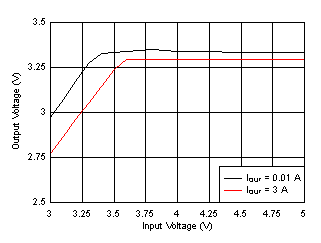
| VOUT = 3.3 V | FSW = 400 kHz | Auto mode |

| VOUT = 5 V | FSW = 400 kHz | Auto mode |

| VOUT = 3.3 V | FSW = 400 kHz | Auto mode |
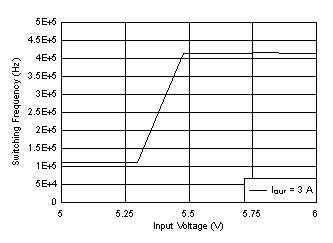
| VOUT = 5 V | FSW = 400 kHz | Auto mode |

| VOUT = 5 V | FSW = 2100 kHz | Auto mode |
| IOUT = 100 mA | VIN = 13.5 V |

| VOUT = 5 V | FSW = 2100 kHz | Auto mode |
| IOUT = 3 A | VIN = 13.5 V |

| VOUT = 5 V | FSW = 2100 kHz | Auto mode |
| IOUT = 100 mA | VIN = 13.5 V |

| VOUT = 5 V | FSW = 2100 kHz | FPWM mode |
| IOUT = 3 A to Short Circuit | VIN = 13.5 V | |

| VOUT = 5 V | FSW = 2100 kHz | FPWM mode |
| IOUT = Short Circuit | VIN = 13.5 V | |
| FSW = 400 kHz | VOUT = 5 V | IOUT = 5 A |
| Frequency tested: 150 kHz to 30 MHz | ||
| Tested on 6-A variant with LM61460EVM | ||
| VOUT = 5 V | FSW = 400 kHz | IOUT = 5 A |
| Frequency tested: 150 kHz to 30 MHz | ||
| Tested on 6-A variant with LM61460EVM | ||
| VOUT = 5 V | FSW = 400 kHz | IOUT = 5 A |
| Frequency tested: 30 MHz to 300 MHz | ||
| Tested on 6-A variant with LM61460EVM | ||
| VOUT = 5 V | FSW = 400 kHz | IOUT = 5 A |
| Frequency tested: 300 MHz to 1 GHz | ||
| Tested on 6-A variant with LM61460EVM | ||
| FSW = 2100 kHz | VOUT = 5 V | IOUT = 5 A |
| Frequency tested: 150 kHz to 30 MHz | ||
| Tested on 6-A variant with LM61460EVM | ||
| VOUT = 3.3 V | FSW = 400 kHz | FPWM mode |
| VOUT = 3.3 V | FSW = 2100 kHz | FPWM mode |
| VOUT = 5 V | FSW = 400 kHz | FPWM mode |
| VOUT = 5 V | FSW = 2100 kHz | FPWM mode |
| VOUT = 3.3 V | FSW = 400 kHz | FPWM mode |
| VOUT = 3.3 V | FSW = 2100 kHz | FPWM mode |
| VOUT = 5 V | FSW = 400 kHz | FPWM mode |
| VOUT = 5 V | FSW = 2100 kHz | FPWM mode |
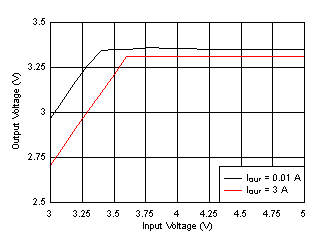
| VOUT = 3.3 V | FSW = 2100 kHz | Auto mode |

| VOUT = 5 V | FSW = 2100 kHz | Auto mode |

| VOUT = 3.3 V | FSW = 2100 kHz | Auto mode |
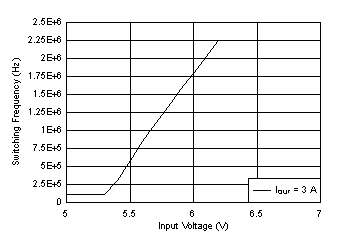
| VOUT = 5 V | FSW = 2100 kHz | Auto mode |

| VOUT = 5 V | FSW = 2100 kHz | FPWM mode |
| IOUT = 100 mA | VIN = 13.5 V |

| VOUT = 5 V | FSW = 2100 kHz | FPWM mode |
| IOUT = 1.5 A to 3 A to 0 A | VIN = 13.5 V | TR = TF = 6 µs |
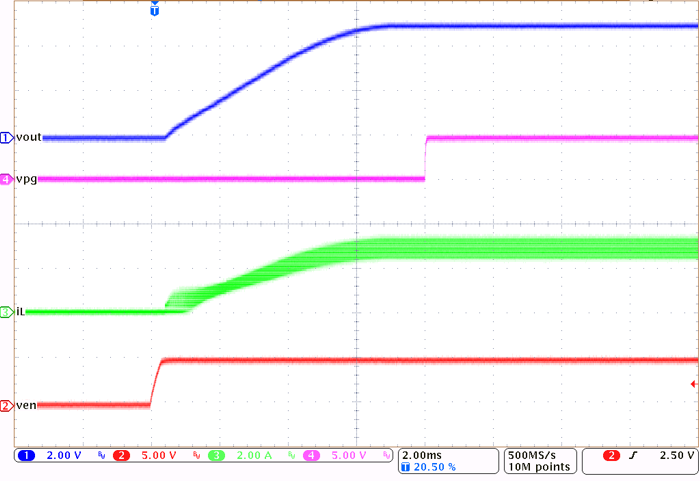
| VOUT = 5 V | FSW = 2100 kHz | FPWM mode |
| IOUT = 3 A | VIN = 13.5 V |

| VOUT = 5 V | FSW = 2100 kHz | FPWM mode |
| IOUT = Short Circuit to 3 A | VIN = 13.5 V | |
| FSW = 400 kHz |
| VOUT = 5 V | FSW = 400 kHz | IOUT = 5 A |
| Frequency tested: 30 MHz to 108 MHz | ||
| Tested on 6-A variant with LM61460EVM | ||
| VOUT = 5 V | FSW = 400 kHz | IOUT = 5 A |
| Frequency tested: 30 MHz to 300 MHz | ||
| Tested on 6-A variant with LM61460EVM | ||
| VOUT = 5 V | FSW = 400 kHz | IOUT = 5 A |
| Frequency tested: 300 MHz to 1 GHz | ||
| Tested on 6-A variant with LM61460EVM | ||
| FSW = 2100 kHz | Note: Measurements taken with LM61460EVM | |
| FSW = 2100 kHz | VOUT = 5 V | IOUT = 5 A |
| Frequency tested: 30 MHz to 108 MHz | ||
| Tested on 6-A variant with LM61460EVM | ||
Table 9-4 BOM for Typical Application
Curves
| VOUT | FREQUENCY | RFBB | RT | COUT | CIN + CHF | L |
|---|---|---|---|---|---|---|
| 3.3 V | 400 kHz | 100 kΩ | 43.2 kΩ | 6 x 22 µF | 2 x 4.7 µF + 2 x 100 nF | 10 µH (XHMI6060) |
| 3.3 V | 2100 kHz | 100 kΩ | 43.2 kΩ | 3 x 22 µF | 2 x 4.7 µF + 2 x 100 nF | 1.5 µH (XEL5030) |
| 5 V | 400 kHz | 100 kΩ | 24.9 kΩ | 4 x 22 µF | 2 x 4.7 µF + 2 x 100 nF | 10 µH (XHMI6060) |
| 5 V | 2100 kHz | 100 kΩ | 24.9 kΩ | 3 x 22 µF | 2 x 4.7 µF + 2 x 100 nF | 1.5 µH (74438356015) |